

 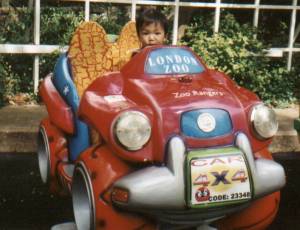 On
Thursday May 2nd, we visited the London Zoo. On
Thursday May 2nd, we visited the London Zoo. |
 London
Zoo is the world's first scientific zoo (opened in 1828), located next to lovely Regent Park.
John
picked up monkey sounds after watching and listening to these monkeys. London
Zoo is the world's first scientific zoo (opened in 1828), located next to lovely Regent Park.
John
picked up monkey sounds after watching and listening to these monkeys. |
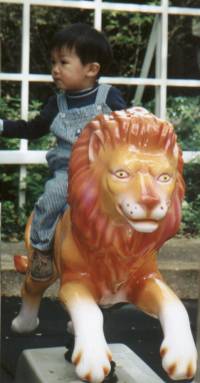 While
John liked seeing the real lions, he loved riding this plastic one. While
John liked seeing the real lions, he loved riding this plastic one. |
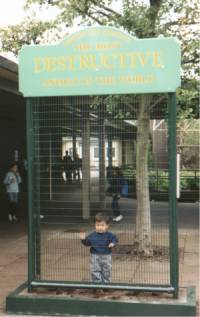 The
sign says "The Most Destructive Animal in the World". The
sign says "The Most Destructive Animal in the World". |
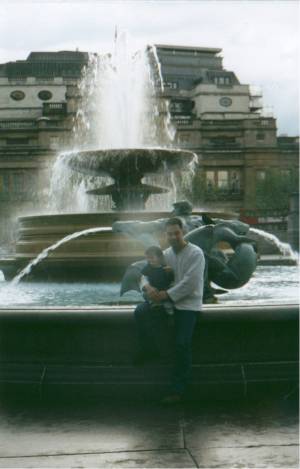 Then
we
visited the British National Gallery at Trafalgar Square. The
square is named for the naval battle won by Horatio Nelson. Big New
Years' Celebrations take place here every year. Here's one of the
four big fountains in the Square. Then
we
visited the British National Gallery at Trafalgar Square. The
square is named for the naval battle won by Horatio Nelson. Big New
Years' Celebrations take place here every year. Here's one of the
four big fountains in the Square. |
 Here's
John warming up his engines to make a mad dash for the pigeons.... Here's
John warming up his engines to make a mad dash for the pigeons....
|
| The British National Gallery
has one of the greatest collection of European art anywhere. We
really liked the Rembrandt Van Rijn collection. After reading Henri
Nouwen's The Prodigal Son about Rembrandt, we've taken an interest
in the work and spiritual life of this 17th century Dutch painter.
Rembrandt is interesting because of the way he paints people. The
light and darkness at first make his paintings stark and austere, but the
closer and longer you look at them, the more you see flesh colors and
warmth in their faces, along with incredible detail. After we came back, Mako visited the Gallery's website and downloaded
these pictures: Belshazzar's Feast is to the right. It portrays events described in the Book of Daniel, from which we get the phrase "the handwriting is on the wall." God's hand writes a doomsday message about the downfall of the Babylonian Empire. The affluence of Belshazzar's robe is amazing here. In general, we love Rembrandt's use of light and darkness. |
 |
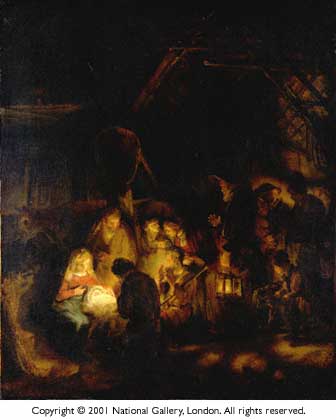 The
Adoration of the Shepherds, portraying the newborn Jesus, Mary and Joseph,
and of course, the shepherds. It's poetic that the source of light
in the scene is the infant Jesus. The
Adoration of the Shepherds, portraying the newborn Jesus, Mary and Joseph,
and of course, the shepherds. It's poetic that the source of light
in the scene is the infant Jesus. |
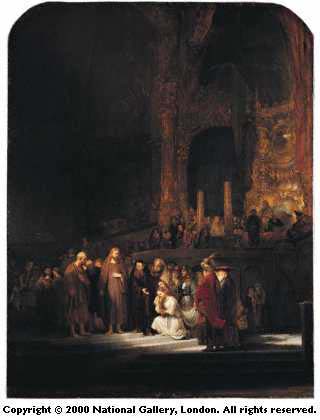 The
Woman Taken in Adultery, portraying John 8:1-11. A woman accused of
adultery is brought before Jesus. The
Woman Taken in Adultery, portraying John 8:1-11. A woman accused of
adultery is brought before Jesus. |
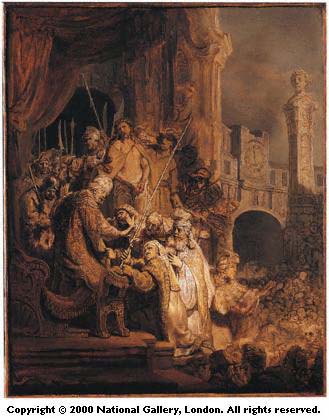 Ecce
Homo, a picture of Jesus before Pontius Pilate. The priests and
Pharisees are pressing the sceptre of judgment into Pilate's hands.
We don't know what the anachronistic clock tower means. Ecce
Homo, a picture of Jesus before Pontius Pilate. The priests and
Pharisees are pressing the sceptre of judgment into Pilate's hands.
We don't know what the anachronistic clock tower means. |
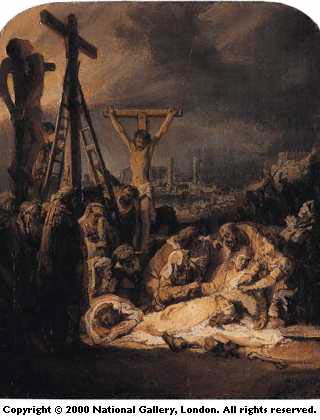 Lamentation
Over the Dead Christ. It shows Mary, the mother of Jesus, Mary
Magdalene and others, weeping over his body after the Crucifixion. Lamentation
Over the Dead Christ. It shows Mary, the mother of Jesus, Mary
Magdalene and others, weeping over his body after the Crucifixion. |